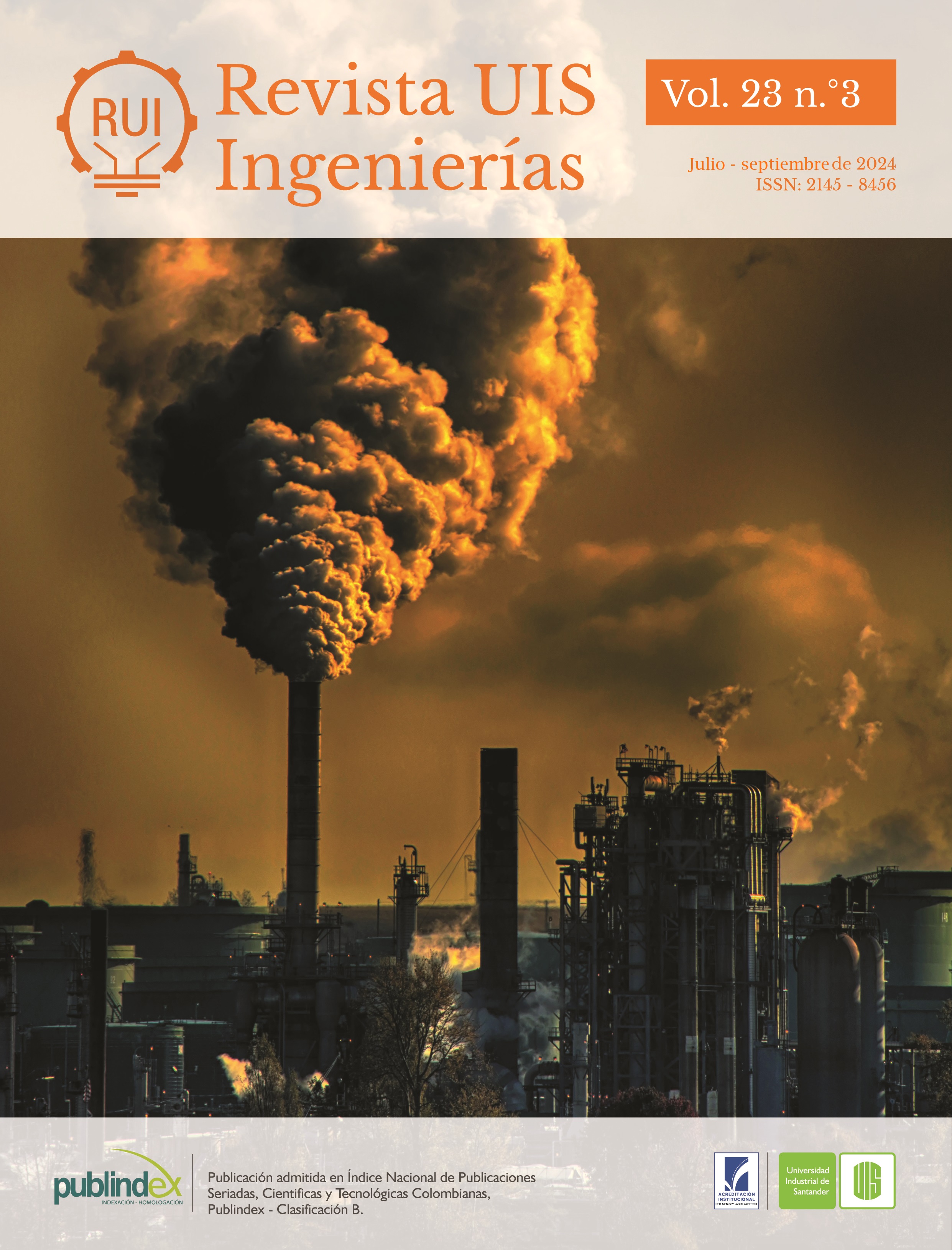Published 2024-08-10
Keywords
- metaverse,
- avatars,
- navigability,
- immersion,
- interaction
How to Cite
Copyright (c) 2024 Revista UIS Ingenierías

This work is licensed under a Creative Commons Attribution-NoDerivatives 4.0 International License.
Abstract
The metaverse is the next major revolution of the internet, enabling communication between users from a virtual perspective mapped to the real world. This technology has attracted significant interest from students, researchers, and businesses, and has proposed multiple applications in sectors such as education, commerce, health, and others. However, its development is in its initial stages, as it is still under discussion how it will be standardized in the face of new proposed solutions. This article presents the theorical framework of the main components that make up a metaverse (3D modeling, Web 3D environment and communication aspects), the methodology implemented for the development of the metaverse of the School of Systems Engineering and Computing – EISC Metaverse, the architecture, the technologies used, and the prototype developed with the components mentioned in the literature review, in addition to discussing the results obtained in developing these types of emerging technologies.
Downloads
References
- S. Mirjalili, “Dragonfly algorithm: a new metaheuristic optimization technique for solving single-objective, discrete, and multi-objective problems,” Neural Comput Appl, vol.27, no.4, pp. 1053–1073, 2016,
- doi: https://doi.org/10.1007/S00521-015-1920-1
- S. Kraus, D. K. Kanbach, P. M. Krysta, M. M. Steinhoff, and N. Tomini, “Facebook and the creation of the metaverse: radical business model innovation or incremental transformation?” International Journal of
- Entrepreneurial Behavior & Research, vol. 28, no. 9, pp. 52–77, 2022, doi: https://doi.org/10.1108/IJEBR-12-2021-0984
- D. P. Barráez-Herrera, “Metaversos en el Contexto de la Educación Virtual,” Revista Tecnológica-Educativa Docentes 2.0, vol. 13, no. 1, pp. 11–19, 2022, doi: https://doi.org/10.37843/rted.v13i1.300
- D. Lulu, and Z. Zheng, “On the Translation of Metaverse,” Terminología científica y tecnológica china,
- vol. 24, no. 3, p. 49, 2022, doi: https://doi.org/10.12339/j.issn.1673-8578.2022.03.007
- H. Duan, J. Li, S. Fan, Z. Lin, X. Wu, W. Cai, “Metaverse for social good: A university campus prototype,” in Proceedings of the 29th ACM international conference on multimedia, 2021, pp. 153–161, doi: https://doi.org/10.1145/3474085.3479238
- B. Zhou, “Building a smart education ecosystem from a metaverse perspective,” Mobile Information Systems, vol. 2022, pp. 1–10, 2022, doi: https://doi.org/10.1155/2022/1938329
- F. De Felice, C. De Luca, S. Di Chiara, and A. Petrillo, “Physical and digital worlds: implications and opportunities of the metaverse,” Procedia Comput Sci, vol. 217, pp. 1744–1754, 2023, doi: https://doi.org/10.1016/j.procs.2022.12.374
- J. Smart et al., “A cross-industry public foresight project,” Proc. Metaverse Roadmap Pathways 3DWeb, pp. 1–28, 2007.
- S. M. Park and Y.-G. Kim, “A metaverse: Taxonomy, components, applications, and open challenges,” IEEE access, vol. 10, pp. 4209– 4251, 2022, doi: https://doi.org/10.1109/ACCESS.2021.3140175
- T. Türk, “The concept of metaverse, its future and its relationship with spatial information,” Advanced Geomatics, vol. 2, no. 1, pp. 17–22, 2022.
- S. Mystakidis, “Metaverse,” Encyclopedia, vol. 2, no. 1, pp. 486–497, 2022, doi: https://doi.org/10.3390/encyclopedia2010031
- J. P. A. Campos, R. Rieder, “Procedural Content Generation using Artificial Intelligence for Unique Virtual Reality Game Experiences,” 2019 Simposio sobre Realidad Virtual y Aumentada (SVR)2019, Río de Janeiro, Brasil, pp. 147-151, doi: https://doi.org/10.1109/SVR.2019.00037
- C. Andrew, Metaverse for Beginners: A Guide to Help You Learn About Metaverse, Virtual Reality and Investing in NFTs. 2022.
- J. D. N. Dionisio, W. G. B. Iii, and R. Gilbert, “3D virtual worlds and the metaverse: Current status and future possibilities,” ACM Computing Surveys (CSUR), vol. 45, no. 3, pp. 1–38, 2013, doi: https://doi.org/10.1145/2480741.2480751
- K. J. L. Nevelsteen, “Virtual world, defined from a technological perspective and applied to video games, mixed reality, and the Metaverse,” Comput Animat Virtual Worlds, vol. 29, no. 1, p. e1752, 2018, doi: https://doi.org/10.1002/CAV.1752
- Y. Zhao et al., “Metaverse: Perspectives from graphics, interactions and visualization,” Visual Informatics, vol. 6, no. 1, pp. 56–67, 2022, doi: https://doi.org/10.1016/j.visinf.2022.03.002
- A. Dudoglo and F. Ritter, Avatar Selection in the Metaverse: How users choose their digital persona in VRChat. 2022.
- A. Alvarez-Risco, S. Del-Aguila-Arcentales, M. A. Rosen, and J. A. Yáñez, “Social Cognitive Theory to Assess the Intention to participate in the Facebook Metaverse by citizens in Peru during the COVID-19 pandemic,” Journal of Open Innovation: Technology, Market, and Complexity, vol. 8, no. 3, p. 142, 2022, doi: https://doi.org/10.3390/joitmc8030142
- G. J. Hwang and S.-Y. Chien, “Definition, roles, and potential research issues of the metaverse in education: An artificial intelligence perspective,” Computers and Education: Artificial Intelligence, vol. 3, p. 100082, 2022, doi: https://doi.org/10.1016/j.caeai.2022.100082
- E. Dincelli, A. Yayla, “Immersive virtual reality in the age of the Metaverse: A hybridnarrative review based on the technology affordance perspective,” The Journal of Strategic Information Systems, vol. 31, no. 2,
- p. 101717, 2022, doi: https://doi.org/10.1016/j.jsis.2022.101717
- D. Jackson, J. Gilbert, “WebGL Specification.” Accessed: Nov. 17, 2023. [Online]. Available: https://registry.khronos.org/webgl/specs/latest/1.0/
- Y. K. Dwivedi et al., “Metaverse beyond the hype: Multidisciplinary perspectives on emerging challenges, opportunities, and agenda for research, practice and policy,” Int J Inf Manage, vol. 66, p. 102542, 2022, doi:
- https://doi.org/10.1016/j.ijinfomgt.2022.102542
- S. Mystakidis, “Metaverse,” Encyclopedia, vol. 2, no. 1, pp. 486–497, 2022.
- “DomoGallery,” [Online]. Available: https://domogallery.vercel.app/
- “Mapa de afinidad - EISC Metaverse,”. [Online]. Available: https://drive.google.com/drive/folders/1eqclHd8w6TEaaplbsfV--0jFeXLmmpml?usp=sharing
- “Proto-personas - EISC Metaverse,” [Online]. Available: https://drive.google.com/drive/folders/1gSq5JhfYLANPcY3SRwJDT-mJGyN32hd?usp=sharing
- “Mixamo,” [Online]. Available: https://www.mixamo.com/
- “EISC Metaverse,” [Online]. Available: https://eiscmetaverse.vercel.app/
- “r3f-perf – npm,” [Online]. Available: https://www.npmjs.com/package/r3f-perf

